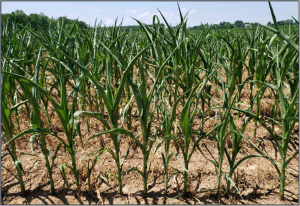by John Hanchar and Joan Petzen
Introduction

Photo: M. Stanyard / CCE NWNY Team
Effects of drought conditions on crops and livestock will challenge farm business owners’ abilities to achieve financial objectives over the next several months. Farm business owners can learn about strategies for dealing with the drought conditions affecting many counties in western New York by reviewing NWNY Program resources and others, for example, Cornell University/CALS/PRO-DAIRY. Some information focuses on the benefits of establishing where you are now with respect to feed quantities, feed needs and others, and where you expect to be over the next several months. Just as the business benefits from such assessments, the business facing drought conditions also benefits from assessing where the business is now and where it expects to be over the next several months with respect to financial performance, for example, with regards to meeting cash flow obligations in a timely manner. Regarding where the business expects to be, budgeting plays and important role. Budgets estimate future financial condition or performance. A budget is a projection.
Budgets
For farm business owners, most budgeting work focuses on estimating expected effects on profit, and on projecting the business’ ability to meet cash obligations in a timely manner.
Key characteristics of budgets include the following.
- Budgeting helps you see what a future period’s financial performance will look like for planning purposes. A budget allows one to project cash flow shortages, plan borrowings, and determine the ability to repay borrowings.
- Budgeting provides the manager with a tool for assessing how well the business is meeting projections, and to identify and correct potential problems.
- Budgets help the farm business owner communicate to others where the business is headed financially.
Examples of budgets include: partial, enterprise, and whole farm budgets for projecting expected effects on profitability and for projecting expected effects on the business’ ability to meet cash obligations; and capital budgets associated with investment analysis. Income statements or cash flow statements that report a past period’s performance, for example, an income statement for the 2019 calendar year, are not examples of budgets. They report actual past performance, and do not project or estimate future financial performance.
Whole Farm Budgets
A whole farm budget examining profitability summarizes expected income, expenses, and profit. A cash flow budget for projecting the business’ ability to meet cash obligations is a summary of the expected cash inflows (cash farm receipts, money borrowed, capital sales, non farm income) and outflows (cash farm expenses, principal payments, capital purchases, withdrawals for family living and other personal withdrawals).
Characteristics include the following.
- Whole farm budgets consider all items including those that are not expected to change from the current, base period to the future period. For example, a cash flow budget projects what the cash flow statement will look like in a future period and reports total values for all inflow and outflow items.
- The most useful, valid projections are obtained when proper procedures are used. LaDue, Schuelke and Mensah-Dartey offer some basic rules to follow to insure useful projections (LaDue, Eddy L., Jacob Schuelke and Virgil Mensah-Dartey. 2000. CASHPRO: A Computer Spreadsheet for Projecting Annual Cash Flows and Pro Forma Income Statements.)
- Project cash flows from accrual (or accrual adjusted) receipt and expense values.
- Exclude unusual occurrences from the base year data used for projections.
- Use causal logic in estimating each receipt and expense item.
- Be sure to adjust for inflation.
- Livestock farms that grow forages or concentrates should carefully assess their forage and, or concentrate balance whenever significant changes are expected in the size or composition of the animal herd or cropping program.
- Conducting sensitivity analysis and seeking critical review of the projections enhance the usefulness and validity of projections.
The CASHPRO electronic spreadsheet with instructions is available at: http://dyson.cornell.edu/outreach/decision-aids. Monthly, whole farm, cash flow budgeting is also an option. Again, see for a monthly cash flow budgeting tool.
To learn more contact John Hanchar – p. 585-233-9249; e. jjh6@cornell.edu or Joan Petzen – p.716-378-5267; e. jsp10@cornell.edu

